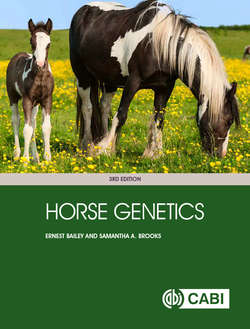Читать книгу Horse Genetics - Ernest Bailey - Страница 52
На сайте Литреса книга снята с продажи.
Other roles of DNA: introns and exons, and regulatory DNA sequences
ОглавлениеAll DNA sequences do not code for amino acids. The sections that code for amino acids are called exons. Most proteins are encoded by (i.e. transcribed and translated from) multiple exons separated by DNA sequences called introns. Together, exons and introns comprise what we have traditionally called genes. When DNA is transcribed into RNA, the entire section of introns and exons is made into RNA. Next, editing enzymes process the RNA strand, clipping out introns to make the final transcript. The final transcript, called messenger RNA (mRNA) is used for translation of the message into the amino acid sequence in the protein. For example, the gene for TRPM1 spans 103,840 bases on chromosome 1 when including all exons and introns. After processing, TRPM1, has five possible mRNA transcripts based on alternate splicing of 24–26 exons with the final transcript ranging in length from 5459 bases to 5630 bases. Fig. 4.3 illustrates a hypothetical intron-exon structure of a gene and the resulting mRNA following transcription and RNA processing to remove 3 introns separating 4 exons.
Fig. 4.3. This image illustrates a hypothetical gene with four exons and three introns. The introns can be very large and the exons very small. The entire exon/intron structure is transcribed then the introns are removed. Following transcription and mRNA processing, only the exons remain.
The most common signal to begin or conclude splicing out a section of DNA occurs at the beginning of the intron (bases GT) and the end of the intron (bases AG). A mutation at the first site will cause inclusion of the intron sequence in the processed mRNA while a mutation at the second will cause deletion of the next exon. Therefore, it is important to consider intron DNA sequences as well as exon DNA sequences when looking for genetic variants that affect genes. This type of variant is called alternate splicing and is implicated in some human diseases and has been identified as the cause of the sabino1 coat color variant in horses. In addition, alternate splicing appears to be normal in the function of many cells and tissues. Various regulatory factors can mask existing splice sites and cause alternate splicing for most genes. We are still learning how this occurs. However, we believe that the creation of proteins with slightly different domains creates proteins with slightly different functions.
In addition to introns and exons, there are large stretches of DNA between genes called, intergenic DNA that separate exon/intron regions. We do not know the role for DNA in these regions, however this DNA is probably important for maintaining special relationships among DNA chromosomal elements and much of it is actually transcribed and may play a role in regulating transcription.
